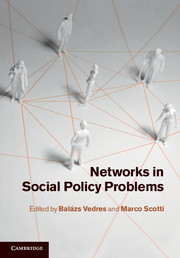Book contents
- Frontmatter
- Contents
- List of contributors
- Acknowledgements
- 1 Introduction
- Part I Information, collaboration, innovation: the creative power of networks
- Part II Influence, capture, corruption: networks perspectives on policy institutions
- 6 Modes of coordination of collective action: what actors in policy-making?
- 7 Why skewed distributions of pay for executives is the cause of much grief: puzzles and few answers (so far)
- 8 Networks of institutional capture: a case of business in the State apparatus
- 9 The social and institutional structure of corruption: some typical network configurations of corruption transactions in Hungary
- Part III Crisis, extinction, world system change: network dynamics on a large scale
- References
- Index
9 - The social and institutional structure of corruption: some typical network configurations of corruption transactions in Hungary
from Part II - Influence, capture, corruption: networks perspectives on policy institutions
Published online by Cambridge University Press: 05 September 2012
- Frontmatter
- Contents
- List of contributors
- Acknowledgements
- 1 Introduction
- Part I Information, collaboration, innovation: the creative power of networks
- Part II Influence, capture, corruption: networks perspectives on policy institutions
- 6 Modes of coordination of collective action: what actors in policy-making?
- 7 Why skewed distributions of pay for executives is the cause of much grief: puzzles and few answers (so far)
- 8 Networks of institutional capture: a case of business in the State apparatus
- 9 The social and institutional structure of corruption: some typical network configurations of corruption transactions in Hungary
- Part III Crisis, extinction, world system change: network dynamics on a large scale
- References
- Index
Summary
In the first part of the chapter, four ideal-typical corruption transactions are explicated in terms of the principal-agent-client model: bribery and extortion are described as two different types of agent-client relationship, while embezzlement and fraud, as two different types of principal-agent relationship. The main idea is to describe these elementary corruption transactions as simple directed graphs. The next section of the chapter takes into consideration different kinds of possible motivation (such as the reduction of risk or transaction costs) of the principals, agents, and clients, in order to embed their corruption transactions in various kinds of personal, business, political, and other institutional networks.
In the second part of the chapter some typical and stable network configurations are presented, based on recent empirical corruption research carried out in Hungary. Certain corruption cases (such as party financing or granting of permits) are analyzed in detail, and are described as complex and multiple networks. The chapter concludes by showing some signs of the evolution of corruption networks in Hungary in terms of the number of actors, the complexity of network configurations, the level of personal or institutional embeddedness, and the multiplicity of relationships.
Introduction
The study consists of two main parts. In the first part, the concept and ideal-types of corruption are defined. The various types of elemental corruption transactions are differentiated in terms of the principal-agent-client model, illustrating them through directed graphs. We distinguish two subtypes of both the agent–client relationship and the principal–agent relationship: bribery and extortion in the former case, embezzlement and fraud in the latter. To conclude the first part, we attempt to delineate the motivational mechanisms that encourage participants in corruption scenarios to embed their transactions in various types of personal, business, political, and other institutional networks. With the help of these networks, those involved are often able to decrease the transaction costs and risks associated with corrupt dealings.
Information
- Type
- Chapter
- Information
- Networks in Social Policy Problems , pp. 156 - 176Publisher: Cambridge University PressPrint publication year: 2012
